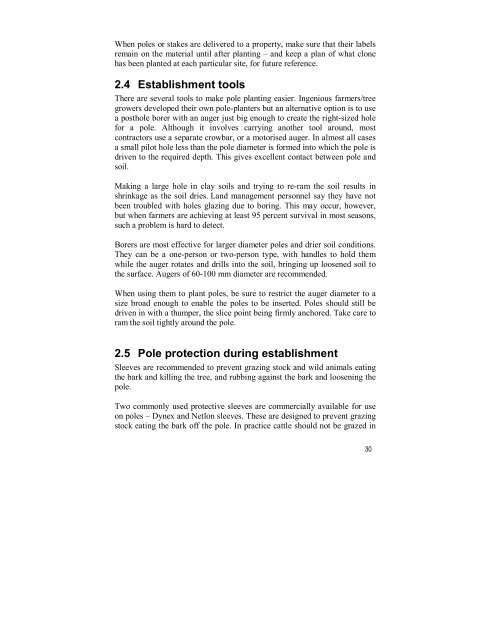Growing Poplar and Willow Trees on Farms, National - FAO
Growing Poplar and Willow Trees on Farms, National - FAO
Growing Poplar and Willow Trees on Farms, National - FAO
Create successful ePaper yourself
Turn your PDF publications into a flip-book with our unique Google optimized e-Paper software.
When poles or stakes are delivered to a property, make sure that their labels<br />
remain <strong>on</strong> the material until after planting – <str<strong>on</strong>g>and</str<strong>on</strong>g> keep a plan of what cl<strong>on</strong>e<br />
has been planted at each particular site, for future reference.<br />
2.4 Establishment tools<br />
There are several tools to make pole planting easier. Ingenious farmers/tree<br />
growers developed their own pole-planters but an alternative opti<strong>on</strong> is to use<br />
a posthole borer with an auger just big enough to create the right-sized hole<br />
for a pole. Although it involves carrying another tool around, most<br />
c<strong>on</strong>tractors use a separate crowbar, or a motorised auger. In almost all cases<br />
a small pilot hole less than the pole diameter is formed into which the pole is<br />
driven to the required depth. This gives excellent c<strong>on</strong>tact between pole <str<strong>on</strong>g>and</str<strong>on</strong>g><br />
soil.<br />
Making a large hole in clay soils <str<strong>on</strong>g>and</str<strong>on</strong>g> trying to re-ram the soil results in<br />
shrinkage as the soil dries. L<str<strong>on</strong>g>and</str<strong>on</strong>g> management pers<strong>on</strong>nel say they have not<br />
been troubled with holes glazing due to boring. This may occur, however,<br />
but when farmers are achieving at least 95 percent survival in most seas<strong>on</strong>s,<br />
such a problem is hard to detect.<br />
Borers are most effective for larger diameter poles <str<strong>on</strong>g>and</str<strong>on</strong>g> drier soil c<strong>on</strong>diti<strong>on</strong>s.<br />
They can be a <strong>on</strong>e-pers<strong>on</strong> or two-pers<strong>on</strong> type, with h<str<strong>on</strong>g>and</str<strong>on</strong>g>les to hold them<br />
while the auger rotates <str<strong>on</strong>g>and</str<strong>on</strong>g> drills into the soil, bringing up loosened soil to<br />
the surface. Augers of 60-100 mm diameter are recommended.<br />
When using them to plant poles, be sure to restrict the auger diameter to a<br />
size broad enough to enable the poles to be inserted. Poles should still be<br />
driven in with a thumper, the slice point being firmly anchored. Take care to<br />
ram the soil tightly around the pole.<br />
2.5 Pole protecti<strong>on</strong> during establishment<br />
Sleeves are recommended to prevent grazing stock <str<strong>on</strong>g>and</str<strong>on</strong>g> wild animals eating<br />
the bark <str<strong>on</strong>g>and</str<strong>on</strong>g> killing the tree, <str<strong>on</strong>g>and</str<strong>on</strong>g> rubbing against the bark <str<strong>on</strong>g>and</str<strong>on</strong>g> loosening the<br />
pole.<br />
Two comm<strong>on</strong>ly used protective sleeves are commercially available for use<br />
<strong>on</strong> poles – Dynex <str<strong>on</strong>g>and</str<strong>on</strong>g> Netl<strong>on</strong> sleeves. These are designed to prevent grazing<br />
stock eating the bark off the pole. In practice cattle should not be grazed in<br />
30

















